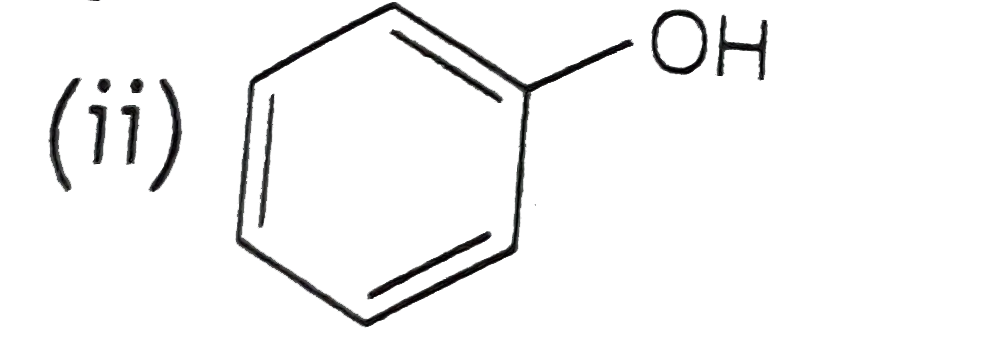How many of the following reagents react with arene diazonium slats to form aryl halides?
i. HBF4/Δ
ii. KHS
iii. CuCN/KCN
iv. CuBr/HBr
v. Cu/HCl
vi. KI/Δ
vii. CH3CH2OH
viii. H3PO2/H2O
The correct Answer is:4
To determine how many of the given reagents react with arene diazonium salts to form aryl halides, we will analyze each reagent one by one.
1. Reagent i: HBF₄ / Δ (Heat)
- When arene diazonium salt reacts with HBF₄ and heat, it replaces the diazonium group (N₂) with a fluorine atom (F).
- Product: Aryl fluoride (Fluorobenzene).
- Conclusion: This reagent forms an aryl halide.
2. Reagent ii: KHS
- KHS introduces a thiol group (SH) in place of the diazonium group.
- Product: Aryl thiol (not an aryl halide).
- Conclusion: This reagent does not form an aryl halide.
3. Reagent iii: CuCN / KCN
- This reagent replaces the diazonium group with a cyanide group (CN).
- Product: Aryl cyanide (not an aryl halide).
- Conclusion: This reagent does not form an aryl halide.
4. Reagent iv: CuBr / HBr
- In this reaction, the diazonium group is replaced by a bromine atom (Br).
- Product: Aryl bromide (Bromobenzene).
- Conclusion: This reagent forms an aryl halide.
5. Reagent v: Cu / HCl
- This reagent replaces the diazonium group with a chlorine atom (Cl).
- Product: Aryl chloride (Chlorobenzene).
- Conclusion: This reagent forms an aryl halide.
6. Reagent vi: KI / Δ (Heat)
- In this case, the diazonium group is replaced by an iodine atom (I).
- Product: Aryl iodide (Iodobenzene).
- Conclusion: This reagent forms an aryl halide.
7. Reagent vii: CH₃CH₂OH (Ethanol)
- This reagent does not replace the diazonium group with a halide; instead, it leads to the formation of a hydrocarbon.
- Product: Benzene (not an aryl halide).
- Conclusion: This reagent does not form an aryl halide.
8. Reagent viii: H₃PO₂ / H₂O
- This reagent also does not replace the diazonium group with a halide; it leads to the formation of benzene.
- Product: Benzene (not an aryl halide).
- Conclusion: This reagent does not form an aryl halide.
Summary of Findings:
- Reagents that form aryl halides:
- HBF₄ (i)
- CuBr / HBr (iv)
- Cu / HCl (v)
- KI (vi)
Total Count of Reagents that Form Aryl Halides: 4
Final Answer:
4 reagents react with arene diazonium salts to form aryl halides.
---
- When arene diazonium salt reacts with HBF₄ and heat, it replaces the diazonium group (N₂) with a fluorine atom (F).
- Product: Aryl fluoride (Fluorobenzene).
- Conclusion: This reagent forms an aryl halide.
- KHS introduces a thiol group (SH) in place of the diazonium group.
- Product: Aryl thiol (not an aryl halide).
- Conclusion: This reagent does not form an aryl halide.
- This reagent replaces the diazonium group with a cyanide group (CN).
- Product: Aryl cyanide (not an aryl halide).
- Conclusion: This reagent does not form an aryl halide.
- In this reaction, the diazonium group is replaced by a bromine atom (Br).
- Product: Aryl bromide (Bromobenzene).
- Conclusion: This reagent forms an aryl halide.
- This reagent replaces the diazonium group with a chlorine atom (Cl).
- Product: Aryl chloride (Chlorobenzene).
- Conclusion: This reagent forms an aryl halide.
- In this case, the diazonium group is replaced by an iodine atom (I).
- Product: Aryl iodide (Iodobenzene).
- Conclusion: This reagent forms an aryl halide.
- This reagent does not replace the diazonium group with a halide; instead, it leads to the formation of a hydrocarbon.
- Product: Benzene (not an aryl halide).
- Conclusion: This reagent does not form an aryl halide.
- This reagent also does not replace the diazonium group with a halide; it leads to the formation of benzene.
- Product: Benzene (not an aryl halide).
- Conclusion: This reagent does not form an aryl halide.
- Reagents that form aryl halides:
- HBF₄ (i)
- CuBr / HBr (iv)
- Cu / HCl (v)
- KI (vi)
4 reagents react with arene diazonium salts to form aryl halides.
Similar Questions
How many of the following compound on hydrolysis form HCl?
(i)NaCl (ii) PCl5 (iii) CH3Cl (iv) NH4Cl (v) BaCl2View SolutionHow many of the following compounds from HCl on hydrolysis as one of the products (major or minor)
(i)BCl3 , (ii)BiCl3 , (iii)SO2Cl2 (iv)NCl3 (v)PCl5 (vi)CrO2Cl2 (vii)CH3Cl (viii)NaClView Solution
Knowledge Check
- Question 1 - Select One
Classify the following as acid or base according to Bronsted - Lowry concept.
(i) CH3COO−
(ii) H3O+
(iii) SO2−4
(iv) HClA(i)(ii)(iii)(iv)Bronsted acidBronsted baseBronsted baseBronsted acidB(i)(ii)(iii)(iv)Bronsted acidBronsted acidBronsted acidBronsted baseC(i)(ii)(iii)(iv)Bronsted baseBronsted acidBronsted baseBronsted acidD(i)(ii)(iii)(iv)Bronsted acidBronsted acidBronsted baseBronsted base
Which of the following compounds (i) and (ii) will not react with a mixture of NaBr and H2SO4. Explain why ?
(i) CH3CH2CH2OH (ii) View Solution
View SolutionWhich of the following reaction(s) can be used for the preparation of alkyl halides ?
(i)CH3CH2OH+HClanhyd.ZnCl2−−−−−−−→
(ii)CH3CH2OH+HCl→
(iii)(CH3)3C−OH+HCl→
(iv)(CH3)2CHOH+HClanhydZnCl2−−−−−−→
View SolutionWhich out of the following is : ( a) the weakest acid (b) the strongest acid ?
(i) C2H5OH (ii) CH3COOH (iii) C6H5OH (iv) H2OView SolutionWhich out of the following is : ( a) the weakest acid (b) the strongest acid ?
(i) C2H5OH (ii) CH3COOH (iii) C6H5OH (iv) H2OView SolutionWhich out of the following is : ( a) the weakest acid (b) the strongest acid ?
(i) C2H5OH (ii) CH3COOH (iii) C6H5OH (iv) H2OView SolutionFind the number of reaction from the given reaction which can show calcination process :
(i) CaCO3.MgCO3Δ−−→CaO+MgO+2CO2
(ii) CuCO3.Cu(OH)2Δ−−→2CuO+H2O+CO2
(iii) Al2O3.2H2OΔ−−→Al2O3+2H2O
(iv) 2Cu2S+3O2Δ−−→2Cu2O+2SO2.View SolutionWhen aniline reacts with HNO2(NaNO2+HCl) diazonium chloride is formed which on reaction with H3PO2 gives:
View Solution

